Do Not Go Birding
Leave the Camera at Home! Be Unprepared!
The Rachel Carson Trail is a network of hiking trails in the greater Pittsburgh area that feature some of the most beautiful natural terrain the region has to offer… and some not so natural. The nearly 50-mile walking route threads its way through meadows, railroad tracks, wooded hills and valleys, busy roads, chattering creeks, and suburban neighborhoods. This trail system is unique in that it doesn’t fall under the auspices of a local, state, or national park service. The majority of the Rachel Carson Trail is located on private land and has been upkept by devoted volunteers since its inception in 1975. Yes, 2025 is the year the Rachel Carson Trail celebrates its quinquagenary. And wouldn’t you know it—the author of Birding with BillBow turns 50 this year too!
Note—“quinquagenary” is one of the worst, most ungainly words I’ve ever encountered in the English language. I vow never to use it again, and I apologize for inflicting it on you, dear readers.
We’re lucky that one particularly stunning section of the RCT called Crouse Run is a quick drive from our house. Just five minutes in the car and we are transported to a mystical forest.
On weekday mornings, my wife Alex ventures to Crouse Run, which she affectionately refers to as “my woods,” for her daily walk. For my part, I enjoy the birdlife there, and I keep Crouse Run in my regular rotation. From spring to fall, that short stretch of woods is home to nesting Veerys, Scarlet Tanagers, Acadian Flycatchers, Eastern Phoebes, Louisiana Waterthrushes, and Wood Thrushes. Behold the song of the Wood Thrush, among the most haunting and ethereal sounds of our woodland habitats.
Most weekends Alex and I take a hike (or two!) together at Crouse Run, sometimes with the boys (our preference), sometimes without (theirs). During those walks, I’m only passively birding. I usually have my binoculars on hand, but just for the rare occasion that some song or flash of color catches my attention. When I do find something, I stop, and Alex, who doesn’t like to break her momentum (in anything), keeps moving up and down the trail until I’ve satisfied my curiosity. Otherwise, we’re there to walk and talk, get some exercise, and make sense of our lives, both familial and creative. Boys or not, it’s one of the loveliest times of the week.
The trailhead is near a busy road, but after a two-minute walk, rock walls cushion the walker from the sounds of traffic and the suburban drone of mowers, leaf blowers, and small children. The path hugs Pine Creek, which babbles over a rocky bed and wends its way through the wooded valley. The roughly mile-and-a-half stretch is beautiful any day of the year, but I find Crouse Run most spectacular after a spring rain, when things are misty, dripping wet, and almost phosphorescently green.
Such were the conditions last Saturday, when Alex and I left the boys at home to have a lazy morning. I was there to converse with my wife and get some steps, but we’re getting into the thick of spring migration, so naturally my birding ears and eyes were slightly more attuned than usual, especially as we passed a couple of the hotspots along the trail.
One such spot is about halfway along our route, a roughly 30-foot stretch flanked by Pine Creek and a stagnant pond that gives life to mosquitoes, amphibians, algae, and the occasional Mallard. During migration, that area can get very hot with migrating warblers and vireos, whose songs blend with those of the birds that have taken up residence and are building nests. In the half minute it takes to pass by, my hearing and vision get a bit more receptive to any clue there might be an interesting bird nearby.
On Saturday, one such clue appeared from nowhere to alight on a shrub, a bright yellow that outshone the greens, grays, and browns of its surroundings. The bird was close, but it swept up the ravine wall and toward the canopy before I could steady my binoculars.
Shit.
That’s warblers for you. Still, I had an educated guess about the bird’s identity. Only the day before I’d seen a similar flash of yellow behind our house that proved to be a Blue-winged Warbler. Beautiful bird, worth stopping for, though hardly a rarity in western Pennsylvania.
I assumed I’d found another Blue-winged, but I wanted to make sure. Alex continued on, instructing me to meet her down the path at the spot where she likes to pause in meditation, soak up the magic of the woods and radiate her energy into the universe.
I was hopeful, if not confident, I’d get another, better look. You never know with warblers. They appear suddenly, and vanish just as suddenly. I was going to give this one about 30 seconds to reappear before I myself moved on. I was prepared to embrace my Blue-winged assumption and get on with the day.
I didn’t have to wait long before the little ball of sunlight reappeared, this time at the edge of the pond, not ten feet from where I stood. I knew even before I had him in my lenses this was no Blue-winged Warbler, but a much rarer bird for Allegheny County—the Prothonotary Warbler.
You can forgive me for the mistake. Like the Blue-winged Warbler, the Prothonotary is a brightly glowing yellow warbler with an olive back and blue-gray wings, though it lacks the white wing bars and black eyestripe of the Blue-winged. With the naked eye, confusing the species is easy.
But a close look at a Prothonotary reveals a warbler of a different hue—there’s a richness to its yellow plumage. A generous suffusion of orange gives it an added depth and warmth, and on this morning it almost appeared lit from within by a glow that was impossible for even a casual observer to miss.
Fun fact—the Prothonotary Warbler is so named because its yellow plumage is reminiscent of the robes once worn by prothonotaries—papal clerks of the Roman Catholic Church.
The Prothonotary Warbler isn’t unheard of in Allegheny County, but I sure hadn’t seen one since moving here, and I knew local birders would be keen to see it too, not to mention add it to their yearly bird checklists.
But who knew how long it was apt to linger. I needed to spread the word ASAP!
But here’s the thing about…
Rare birds—ideally you have photographic evidence, maybe a sound recording, some compelling evidence to convince birders their efforts, which often include a long drive, will not end in heartbreak.
Me—I was unprepared. I didn’t have my good camera. I had a cellphone with a battery I was alarmed to discover had a paltry 3% charge that the camera would quickly suck down to zero. Still, the bird was close, about as close as a warbler ever gets. If I was quick and kept my head, I could get a photo and post it on our local birding chat group on Messenger.
Crouse Run—Cellphone reception there is absolutely dreadful, usually a refreshing circumstance, but on this day reason to panic.
First things first—get the picture. I fumbled at first, startling the bird away but not far. I managed to regain my composure, inch closer, and get a higher quality shot than I could have hoped for. There. I had my photo evidence—no chance this could be mistaken for any other bird.
Next, send a text to the Messenger group. My fingers flailed but I typed out an announcement that was brief but would suffice—
Prothonotary Warbler, Rachel Carson Trail
Trail between Mineo’s and Sample at the pond
I hit send and then waited, watching the sending… notification for what seemed a fortnight. Alex meanwhile had doubled back, no doubt sensing I was seeing something special. When I saw her coming, I gesticulated wildly in what I assume was the most awkward victory dance Crouse Run had ever witnessed.
Amid my euphoria from finding the bird, I died seventeen deaths waiting for the text to send, extreme emotions duking it out, neither giving an inch before the sent notification at last came through. When the message was finally disseminated, the birding community responded with the usual questions about coordinates, where to park, what the trail conditions were, all of which I was happy to provide while my phone had life. There’s nothing I love more than when a rare sighting brings the birding community together.
The final step was to log the sighting on eBird. I fired up the app, entered Prothonotary Warbler, described the species to satisfy the app’s skepticism about the rare bird sighting, and watched the life in my phone flicker out before I could hit Submit.
I like to think of myself as a fairly level-headed birder. I’m not super competitive, and I genuinely enjoy the successes of others. But something kicked in on Saturday. I found the bird, and I wanted to stake my case that I too could be a rare bird finding guy. I confess that I really, really wanted to be the first to report this bird on eBird.
Go, run!, said Alex, instructing me to get to the car and recharge my phone. And run I did. I ran with the speed only a middle-aged husband/dad/bird enthusiast in boots can achieve. A half mile and two hours later, I made it to the car, staved off a coronary, and waited several eternities for the phone to revive. When the apple logo illumined my screen, I submitted my sighting and let out my most profound exhale since our children were safely delivered into the world. Ha. Just kidding. But relieved I was.
This was it. My moment. My time to shine. For once, I had found a bird everyone would want to see. I sat back and waited for Alex, not a little pleased with myself and silently drafting my acceptance speech for whatever honor they’d be handing out.
And the award for High Achievement in the Finding of a Somewhat Rare Warbler goes to—Nathaniel Bowler!
I was excited. The bird was active. It was singing. It was as sociable a warbler as I’d ever encountered. Everyone was gonna see this bird.
But when the birding community descended on Crouse Run, Mr. Prothonotary was nowhere to be found. I monitored the situation from home for the rest of the day, but when further reports of the bird did not appear to be forthcoming, I began drafting a new speech, this time in defense of my honor. Accusations that I was a stringer would soon rain upon me. Surely a tribunal of some kind awaited.
Stringer—A person who intentionally falsifies a bird sighting.
In truth, I needn’t have worried—I had a photo that was time and location-stamped. The sighting was real, and I could prove it in Bird Court if necessary. I fell asleep that night a lot joyful but also a little disappointed—I wanted my friends around town to get the bird too.
After a fitful sleep, I awoke to a happy notification—the bird had been re-found at approximately 6:30 a.m. Hopefully many others would find it. With luck, I’d have the chance to go back and get better pictures.
It happened that our dear friends Craig and Jessica (AKA Cressica from my old blogging days), had come to town for an overnight visit that Saturday afternoon. My hope was that on Sunday morning, we could all hike Crouse Run together. Once we reached the pond, I’d stop and photograph the Prothonotary with my great big zoom lens. I knew other birders would be there. On the trail, I ran into John, a terrific birder I’ve met in the field numerous times. He hadn’t found the bird yet but was sticking around in the hope it would turn up again. We stopped at the pond and waited while Alex and Cressica walked on.
For the next half hour, there was no Prothonotary. There wasn’t much of anything aside from a few anxious birders hoping for a glimpse. But at almost the same moment my three companions returned, John found the Prothonotary, and we all got to enjoy him.
John and I quickly got to work with our cameras. I switched between manual and autofocus, taking dozens of shots but all with the sinking feeling I was failing to get anything in focus. I had more confidence in John. I’ve seen his work. Still, I snapped away, and I hope I managed to capture some essence of how I’ve described the bird in words, if not a crisp photo.
Warblers are constant motion. They rarely pause in pursuit of their favorite snacks. This one was making things easy as he bounced lazily around the pond, taking a respite on one perch and then another. At one point, he landed on a stick not five feet in front of us and burst into song. This was it! The opportunity had come to capture my prize bird in a way that was worthy of its golden splendor.
John seized the moment too. There we were, two birders side by side, but not the same.
Here’s my photo.
And here’s John’s.
I chuckled as I beheld my full collection of blurry photos later that day. My suspicion that I had blown it big time had been warranted, but I don’t take these failures hard. I accept my limitations and focus on the bird. That’s what it’s all about for me—basking in the beauty of these incredible winged creatures who live among us.
And as for awards, just go ahead and give mine to John. That shot is mesmerizing.
The Prothonotary Warbler did not make a permanent summer home of Crouse Run. I’ve been back several times but haven’t seen him since that Sunday. Presumably he’s long gone, bound for whatever swampy habitat he chooses to make his breeding grounds. I’m grateful for his generosity that Saturday in showing himself to me as we hiked. I’m grateful he stuck around for others to see. I’m grateful too for the lesson that was reinforced last Saturday—leave the camera at home sometimes. Go ahead, don’t charge that phone. Because amazing things happen when you remember to not be birding.
Featured Photo—Prothonotary Warbler
Screw it. Instead of searching and not finding a photograph worthy of being featured, enjoy a few vastly superior shots of Allegheny County’s most famous Prothonotary Warbler through the lenses of…
danmendenhallphotography. Dan is an uber-talented birder, photographer, and painter I encounter frequently in the field. Subscribing to his Instagram account can only improve your life.
edtechfocus. Ed, my neighbor, is a wonderful guy with a keen and sensitive eye for nature photography. Ed found a rare bird himself a few weeks ago. I never tracked down that Red-throated Loon, dammit, but I’m happy for Ed and everyone else who managed to see it. Subscribe to Ed’s Insta!
junco.56. Misery loves company. My dear friend Sofia and I chased Ed’s Red-throated Loon together. And we failed together. Still, Sofia is one of the rising stars of the Allegheny County birding community, and I’m hoping she starts spamming my Instagram feed with bird photos soon.
10/10 Recommends
Speaking of birthdays, the quinquagenary 😏 of my wife’s birth is sneaking up on her as well, but she’s not there yet. Please join me in wishing Alex a very happy 48th year. We’ll be celebrating her birthday tomorrow by visiting the Carnegie Museum, buying flowers for the yard, eating carbonara, and watching Walk the Line, which we haven’t seen since the mid-2000s, when Alex was experiencing a full-scale Johnny and June/Carter Family obsession. The best birthday present you could get Alex is to help her reach 1,000 subscribers on YouTube channel so that YouTube will begin sharing the revenue it makes from her efforts. Sabana Grande Productions is Alex’s tribute to love, family, and storytelling, and she’s sooooo close to one thousand. Please help us get there!
That’s all for this week. How’s your migration going? Have you seen a Prothonotary Warbler this spring? Do you have a favorite among warblers? As always, let me know in the comments! 👇
nwb
Enjoy this post? Birding with BillBow’s weekly content will always be free, but you can help support my writerly dreams in the form of a paid subscription (save $10/year by choosing the yearly plan!).
Or buy me a beer. I love to celebrate rare birds with a frothy mug of beer.
Paid or not, thank you for reading! I’m so glad you’re here!
This post was human generated. All photos by Nathaniel Bowler except where noted.


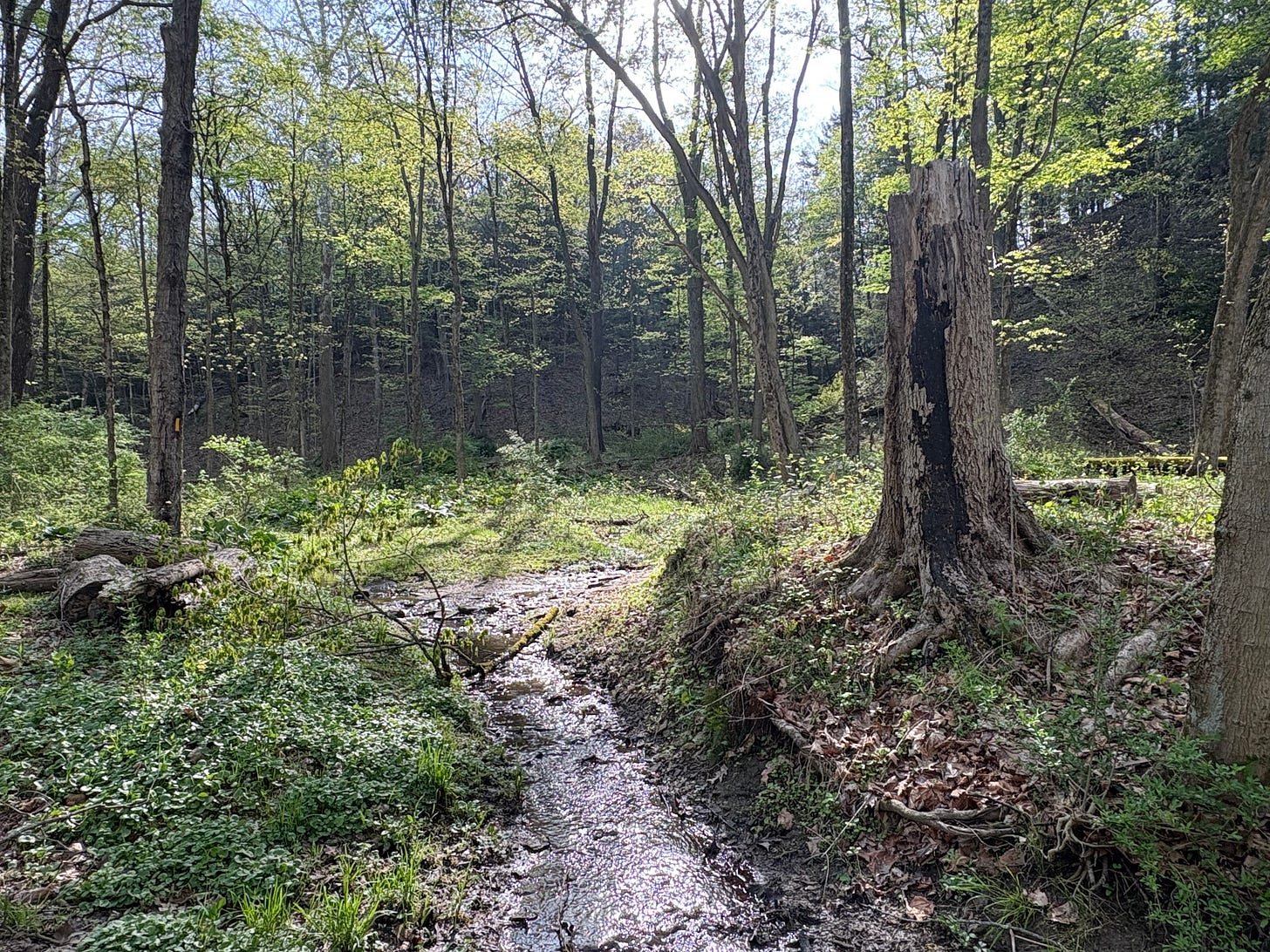
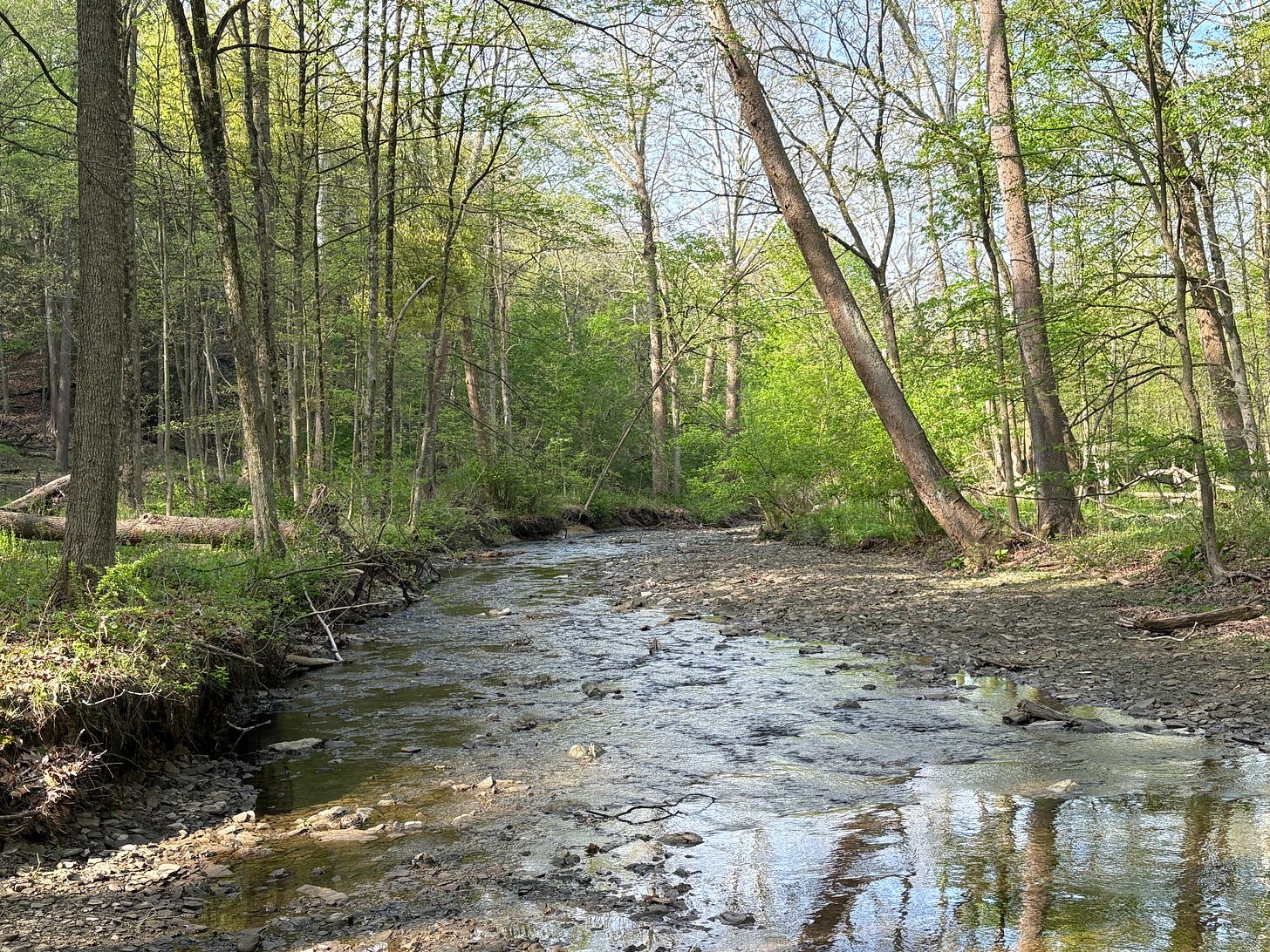
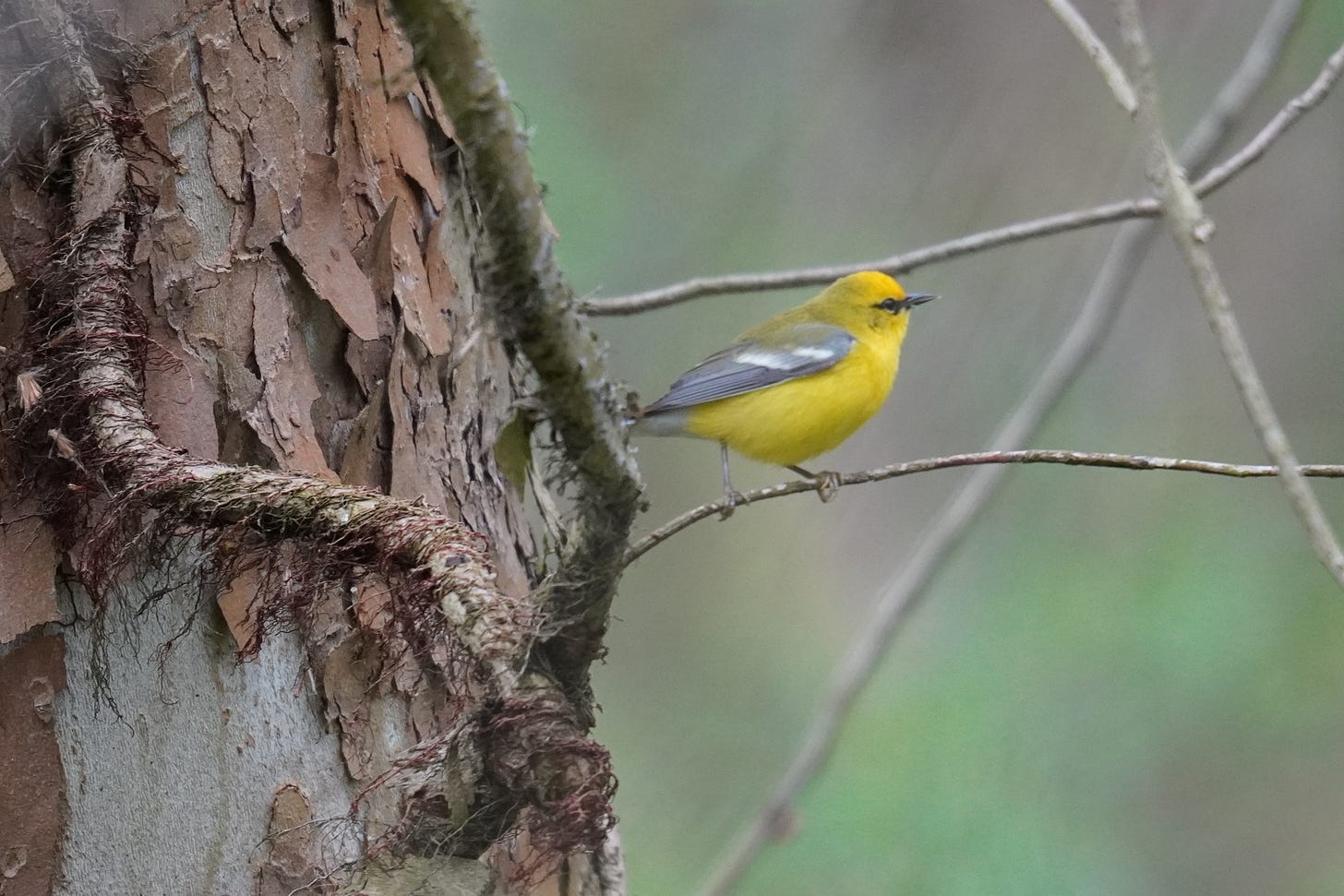
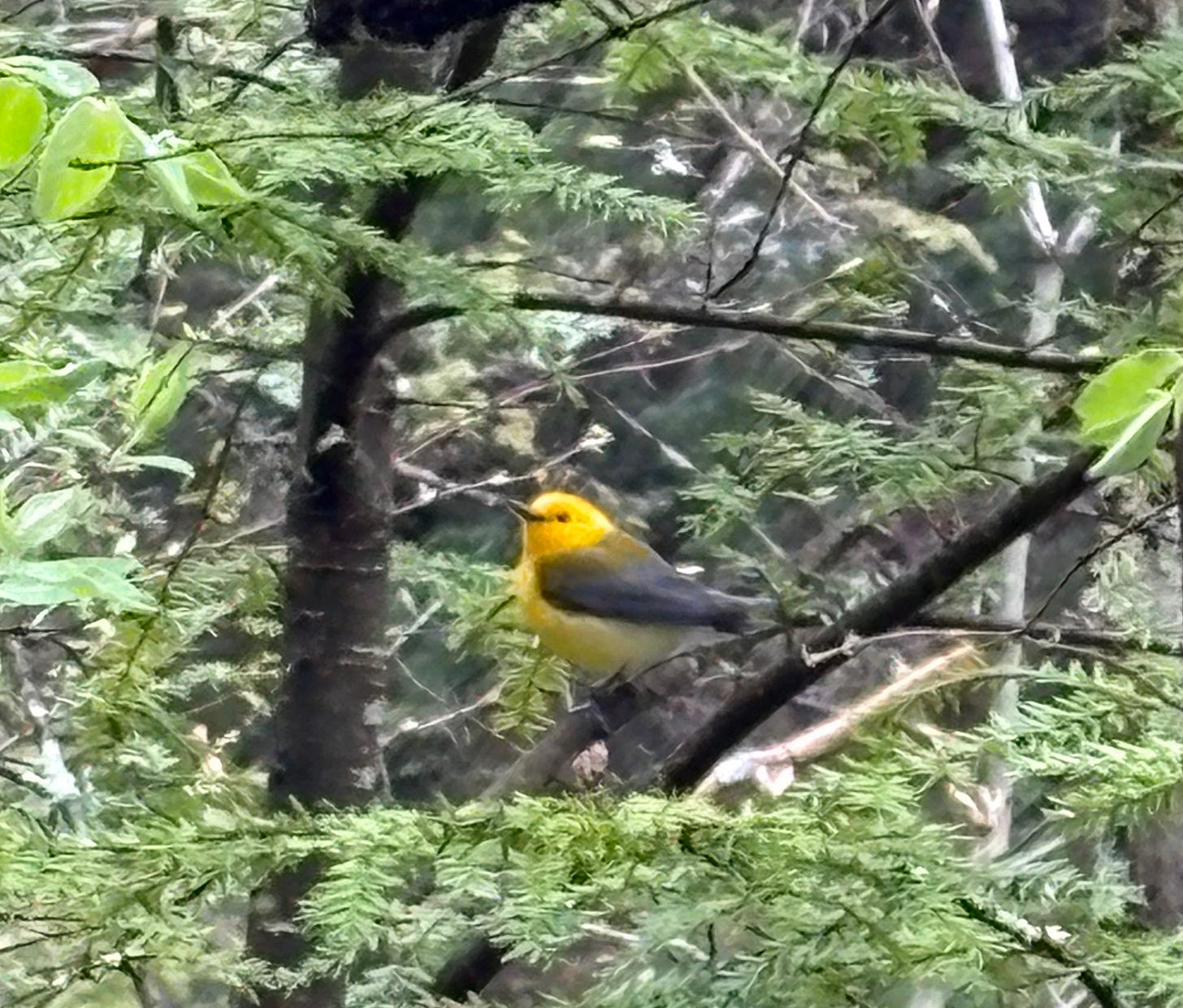

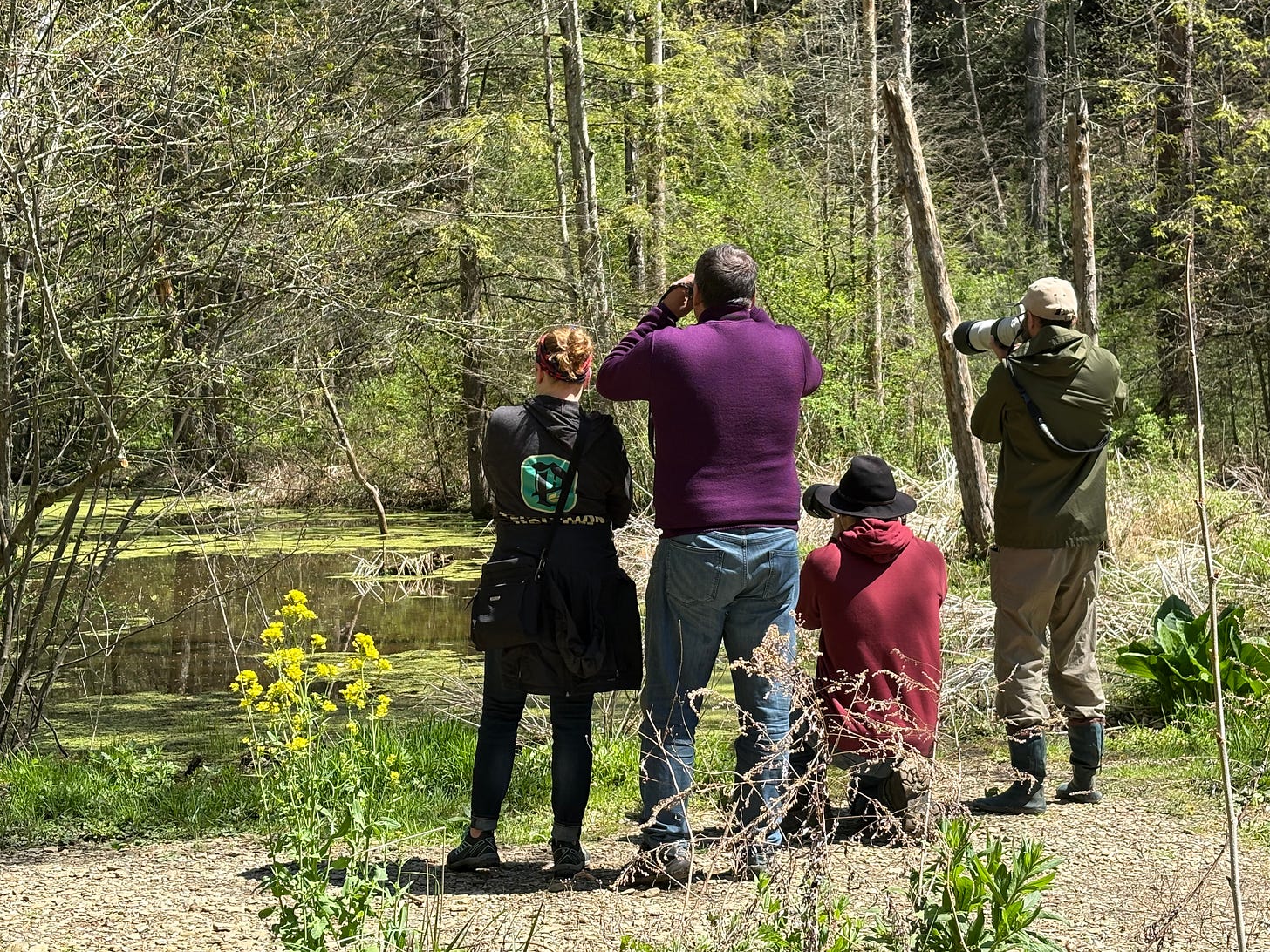
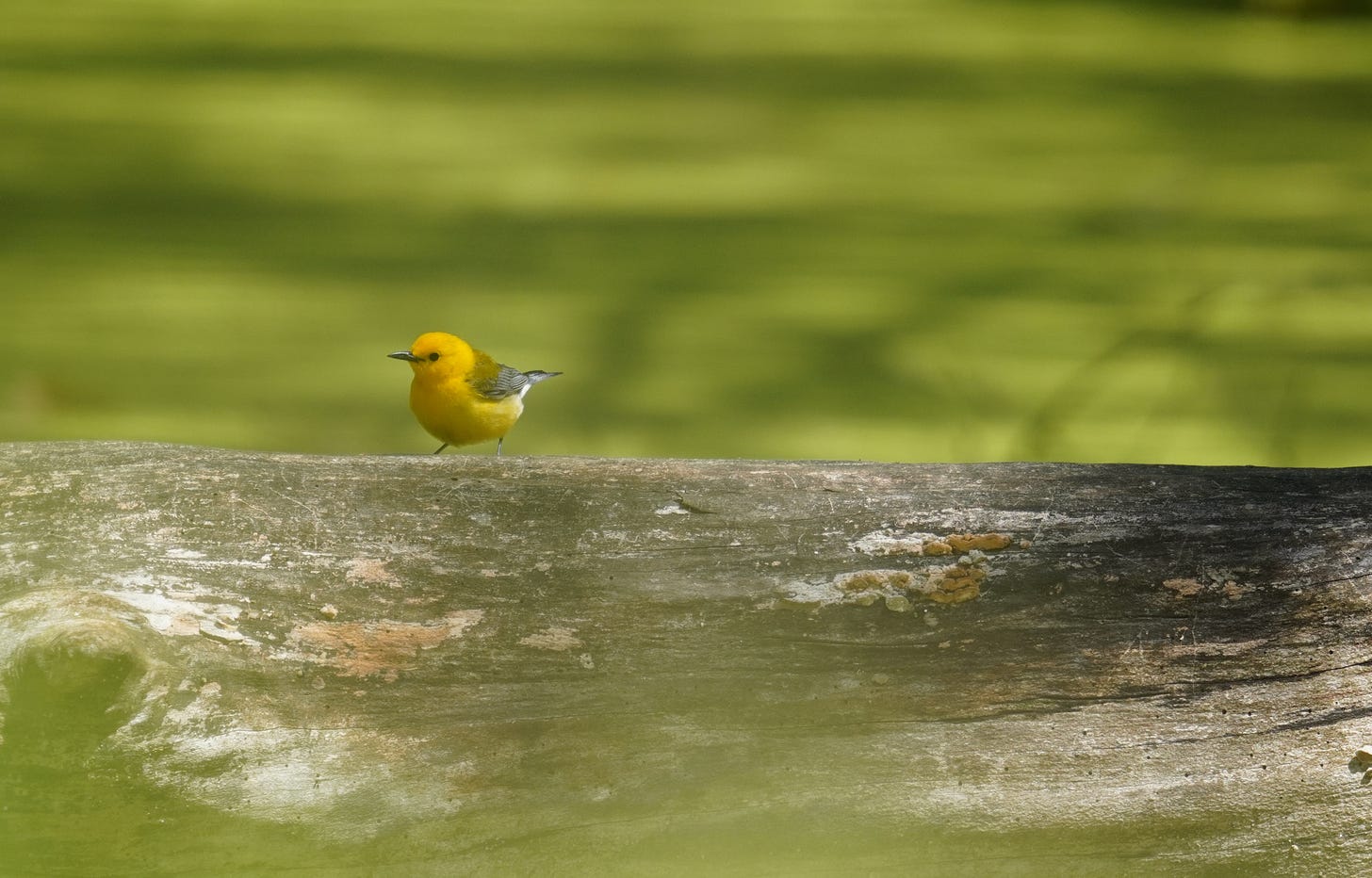
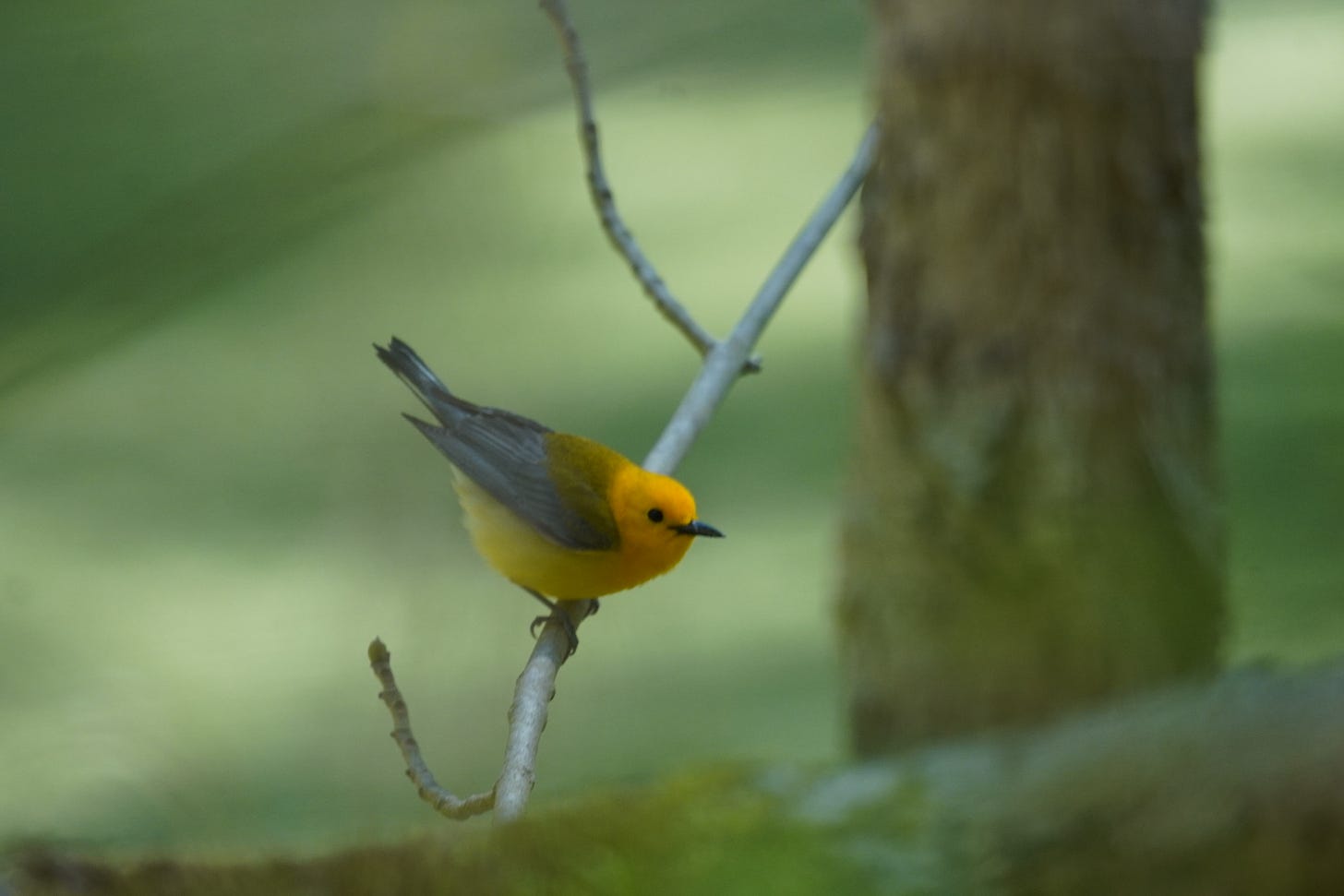
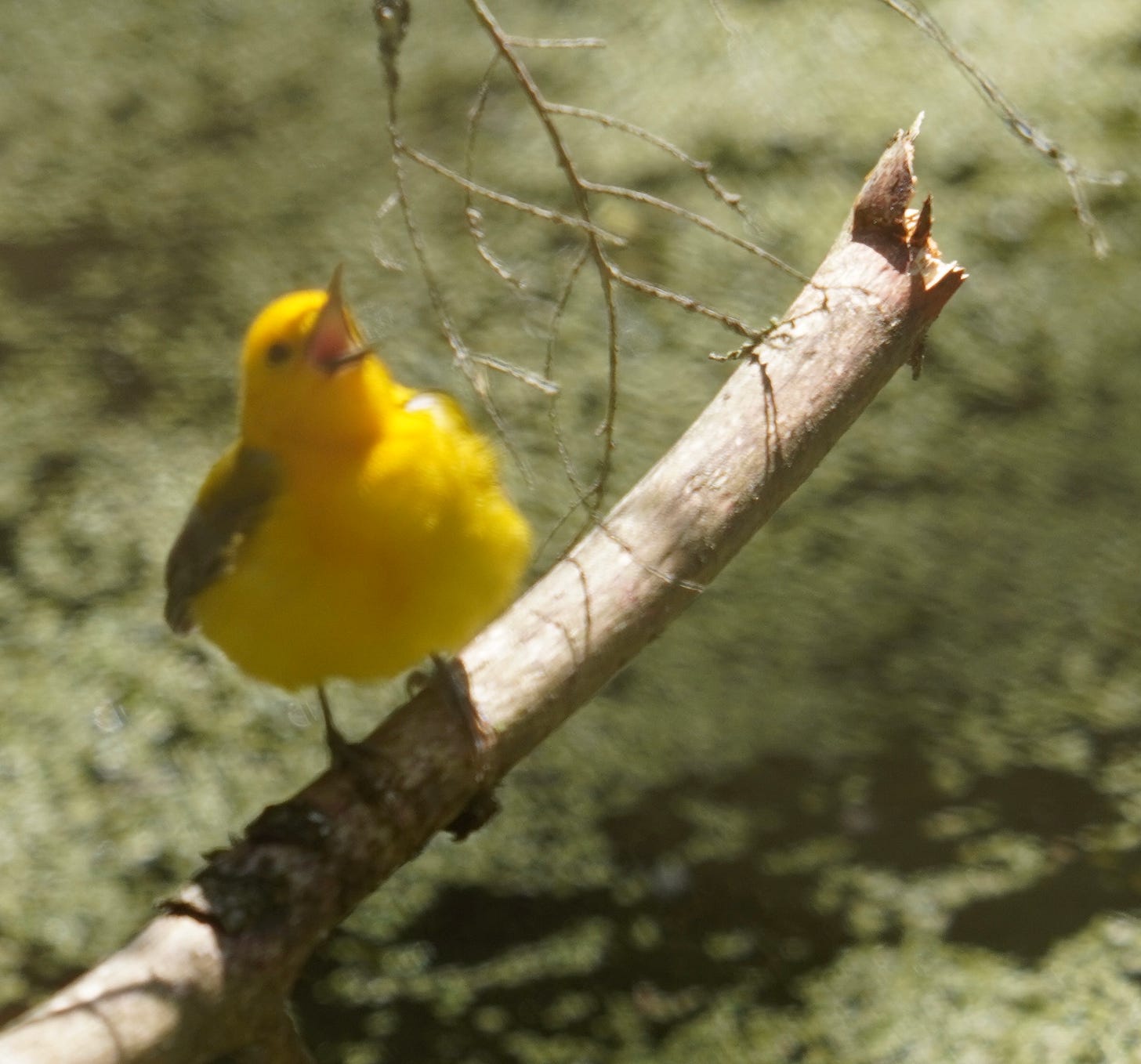
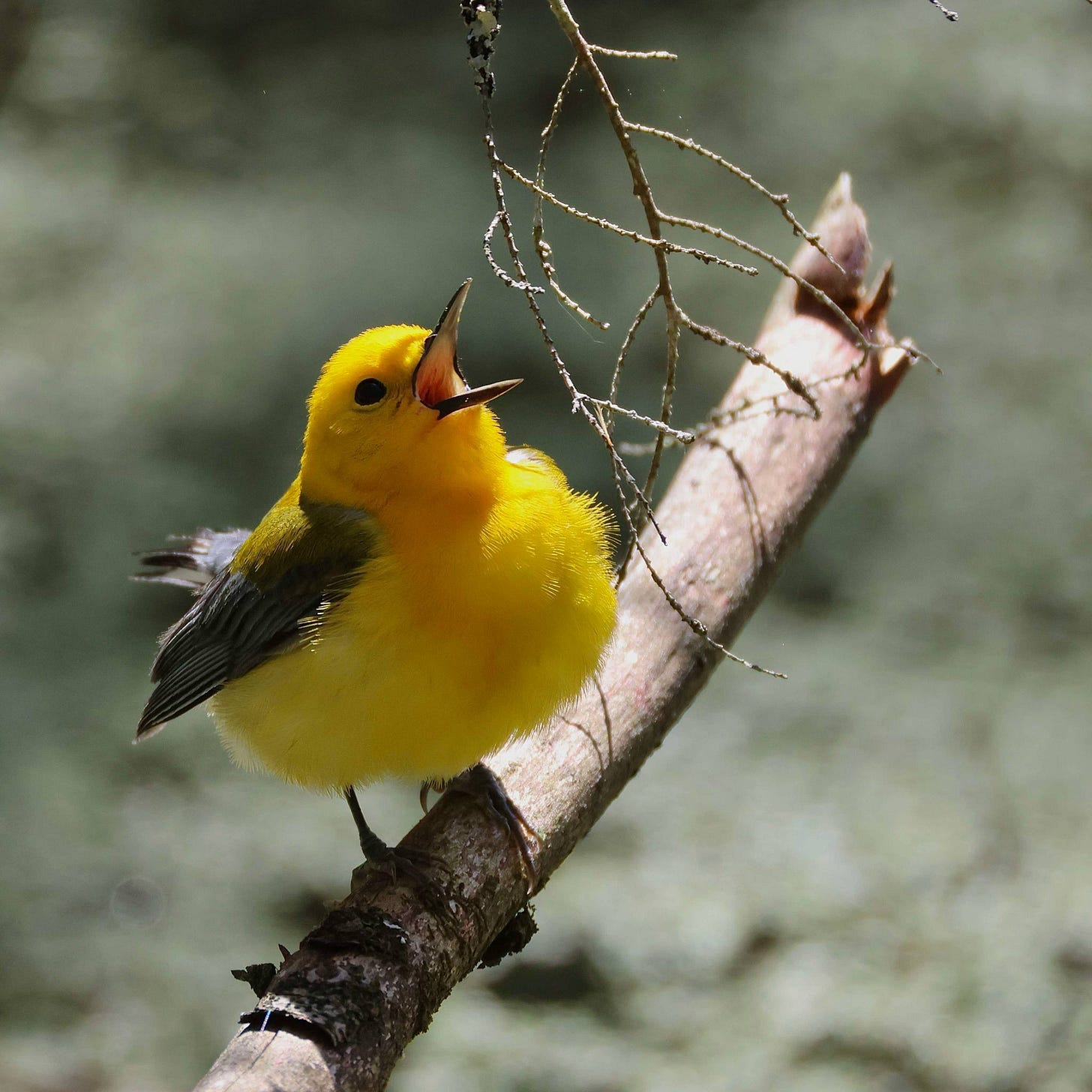
What a thrilling tale! An unlikely hero stumbles upon a rare and coveted creature in a mythical forest… will he get the word out before the (insert fantastic phrase to represent cell phone) dies???
But seriously, Crouse Run is so underrated! From now on, I’m dedicating every visit to that pond: the magical warbler (and kinglet) spot. It’s had all the activity the past couple times I’ve gone!
You really had such a great find. I think a lot of people would’ve missed the Prothonotary. I’m glad he popped back up before the 30 seconds ran out! He seemed a little fickle after that, lol. I swear he knew how badly everyone wanted to see him.
What a dramatic reporting experience too! Your phone dying and the run to the car put the peak right on Freytag’s pyramid. I’m so glad you were able to get the coveted (and earned!) first eBird report! We all pretend we don’t care, but let’s be honest, we definitely do.
John really is such a great photographer. I could totally make an equally embarrassing side-by-side of our Northern Shrike pics. And I could do the same with my Prothonotary shots next to Dan’s; he and I were right next to each other taking photos, lol. I’m the same way though; I love your philosophy! For me, it’s about enjoying the bird--I’m definitely not a photographer.
Also, thank you so much for featuring my Instagram! It’s an honor to be in such great company in that section.
Your photo definitely has a very endearing, meme-able quality